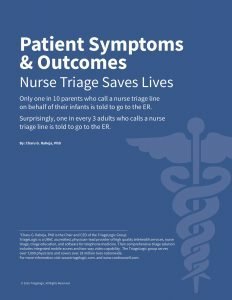Winter and holiday season is coming and that means that doctor offices and triage nurses around the country are preparing for the high influx of patient phone calls during the season. Many calls can be handled over-the-phone with home care advice, while others require patients to come into the office. Schmitt-Thompson triage protocols for doctor offices (see, for example, myTriageChecklist), are an important resource for telephone triage nurses to use to ensure that all calls be handled using the same high-level standard of care.
Still, some symptoms are harder to evaluate than others. One such group of symptoms are those associated with colds versus the ones for patients with a flu-like symptoms. People often don’t know the differences between the cold and the flu, or they might misinterpret the signs and symptoms between the two. The importance of being educated on the cold versus the flu can help nurses take accurate steps in assessing and treating patients.
What is the common cold?
The common cold is a mild illness caused by an infection in the upper respiratory. Colds are contagious and can usually last up to 10 days. There are up to 200 viruses that can cause the common cold.
What is influenza?
Influenza or “the flu” is a more severe illness caused by an infection in the upper and sometimes lower respiratory. The flu is contagious and can last from five days to two weeks depending on severity.
The Differences between a Cold vs. the Flu
The cold and flu are both respiratory illnesses. However, they are caused by different viruses. They can both show very similar symptoms, making it difficult for patients to distinguish the symptoms (see for example, this article by the CDC). The flu is considered worse than the common cold. Flu symptoms are a lot more persistent and are more intense compared to cold-like symptoms which are tamer. For instance, with a common cold, patients are more likely to have a runny nose or a sore throat. The flu can be associated with aggressive symptoms such as a fever or aches, and it can sometimes lead to more serious complications.
How to Spot the Differences Between a Cold vs. the Flu
In general, it usually difficult to assess the symptom differences between the cold and the flu. A special test can be done within the first few days after contracting the flu to determine if a patient has it.
Tips for Nurses on Triaging Patients with a Cold or the Flu
In order to triage patients with the appropriate protocols, nurses should become familiar with the different signs and symptoms of a cold and the flu. The attached video is also a great resource.
Cold Symptoms:
Cold symptoms are milder compared to the flu. Colds usually begin slowly and gradually. Patients can often show signs and symptoms of:
● Sore Throat
● Nasal Congestion/Drainage
● Coughing and Sneezing
Flu Symptoms:
Flu symptoms are more severe and unlike colds, flu symptoms usually come on very quickly. Patients can often show signs and symptoms of:
● Higher Fever
● Headache
● Muscle Aches and Soreness
Severe health complications with the flu can occur such as sinusitis, bronchitis, or ear infections.
If cold or flu symptoms occur triage nurses can advise home care treatment. Home care treatment is the most effective way of ridding a cold or the flu. Home care treatment can include adequate bed rest, avoiding physical exertion, and drinking plenty of fluids. For fevers, it is recommended to take over the counter anti-inflammatory pain relievers such as acetaminophen (Tylenol) or ibuprofen (Advil). If patient fever symptoms become worse it is best for the patient to be advised to see a doctor.
To avoid possibly contracting the flu or cold triage nurses can suggest to patients to regularly wash their hands and avoid close contact with others infected. Patients should also be encouraged to receive an annual flu vaccination. Getting the flu shot is the most effective way of prevention from the flu.






